The concept of using chatbots for customer-brand interactions isn’t new. In fact, they’ve been demonstrating their effectiveness since the 1960s across multiple industries.
However, the boom in eCommerce during the Covid-19 pandemic made them mainstream. They revolutionized eCommerce brands by providing new ways to engage customers — potential and existing.
Besides simulating real-time conversations, advanced feature-equipped eCommerce chatbots can support the entire customer lifecycle by processing payments, order tracking, and more.
In essence, they can do much more than provide a “live 24/7 chat experience” to customers. A report by Grand View Research states that the global chatbot market size will cross $27 million by 2030. This speaks volumes about the significance and effectiveness of chatbots in brand building.
In this post, we will share the proven advantages of using chatbots in eCommerce with relevant examples reflecting its capabilities. So, let’s get started!
Content:
- What is an eCommerce chatbot?
- Core advantages of eCommerce chatbots
- Identifies customer needs and pain points
- Responds to customers’ FAQs without the need for human intervention
- Assists with taking orders
- Assists with sharing relevant product information
- Helps brands collect accurate, real-time customer feedback
- Conclusion
What is an eCommerce chatbot?
An eCommerce chatbot is a computer program that leverages artificial intelligence (AI) and natural language processing (NLP) to foster healthy customer interactions on the website. These interactions occur based on predefined triggers, conditions, and events around the customer journey.
Here’s an excellent example.
Let’s say you visit an eCommerce website to explore their products. However, you can’t decide what product to choose from the multitude of options. So, for assistance, you click the chat option on the website.
The chatbot immediately throws questions to understand your intent or query. Based on your response, the eCommerce chatbot presents the next steps. In this instance, it can ask you for details on what kind of product you are looking for, your budget, and more.
That’s how eCommerce chatbots analyze your details and share personalized responses!
The best part? eCommerce brands can leverage chatbots to foster communication across multiple channels, including messaging applications like WhatsApp, Telegram, etc., social media platforms like Facebook, Instagram, etc., and more.
This tactic can help ensure a consistent brand voice across channels, thus strengthening the omnichannel marketing strategy. Moreover, this can help boost brand awareness and engagement, thus driving customer loyalty.
Tip: With tools like the SendPulse chatbot builder, eCommerce brands can create a customized chatbot for Facebook Messenger, Instagram, Telegram, and WhatsApp with a few clicks. This can help provide a unified experience to the customers across multiple channels.
The best part? It requires absolutely zero coding skills to set up the chatbot.
Core advantages of eCommerce chatbots
Here are the five proven competitive advantages of eCommerce chatbots.
Identifies customer needs and pain points
eCommerce chatbots leverage advanced technologies like artificial intelligence (AI), machine learning, and natural language processing (NLP). This empowers them with capabilities, such as engaging in conversations with customers and accessing crucial information, such as their purchase history, past interactions, etc.
Most importantly, eCommerce chatbots can effectively track customer behavior in real-time and analyze details like —
- What pages did the customers visit?
- What products did they view?
- What products did they add to their cart?
- When did they abandon the shopping cart?
With these insights, eCommerce chatbots can analyze minute patterns and trends that indicate customer pain points and needs. For instance, they can identify if the customers are facing issues with finding a specific product, payment hassles, and more.
The result: The valuable insights allow eCommerce brands to tailor their services, products, and marketing strategies. It can help brands meet and exceed customer expectations, thus boosting engagement and loyalty.
Observe how LEGO, a leading global manufacturer of play materials, leverages a chatbot. Notice how the pop-up appears on the eCommerce website.

Here’s how Sophia, Lego’s chatbot, analyzes customer needs and pain points to offer personalized responses.
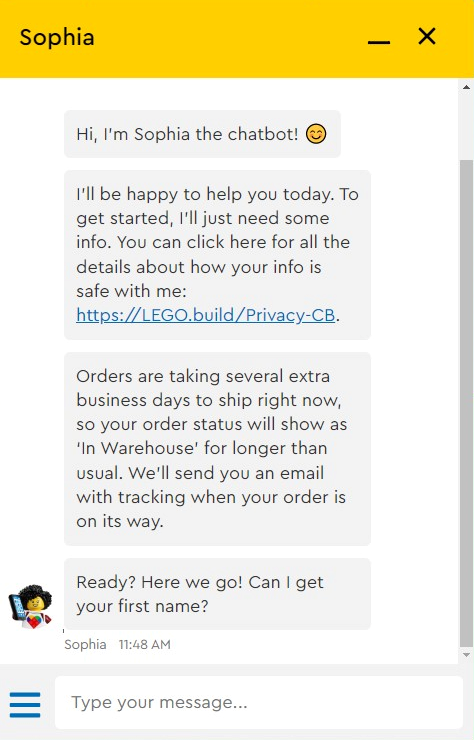
Sophia is highly conversational and assists with freely typed messages. The responses and interactions don’t sound scripted at all.
Responds to customers’ FAQs without the need for human intervention
Chatbots can automate customer service inquiries, thus saving time, effort, and resources for eCommerce businesses. For instance, eCommerce chatbots can address FAQs related to the below-shared topics without the need for human agents:
- Brand policies include product information, shipping times, and return policies.
- Order tracking, for instance, real-time updates on order status, delivery dates, and other information.
- Transaction assistance like billing and payment options, billing statements, etc.
- Technical support, for example, troubleshooting instructions and resolving general issues.
The result: This feature frees human resources to focus on complex issues and improves response times, thus boosting engagement.
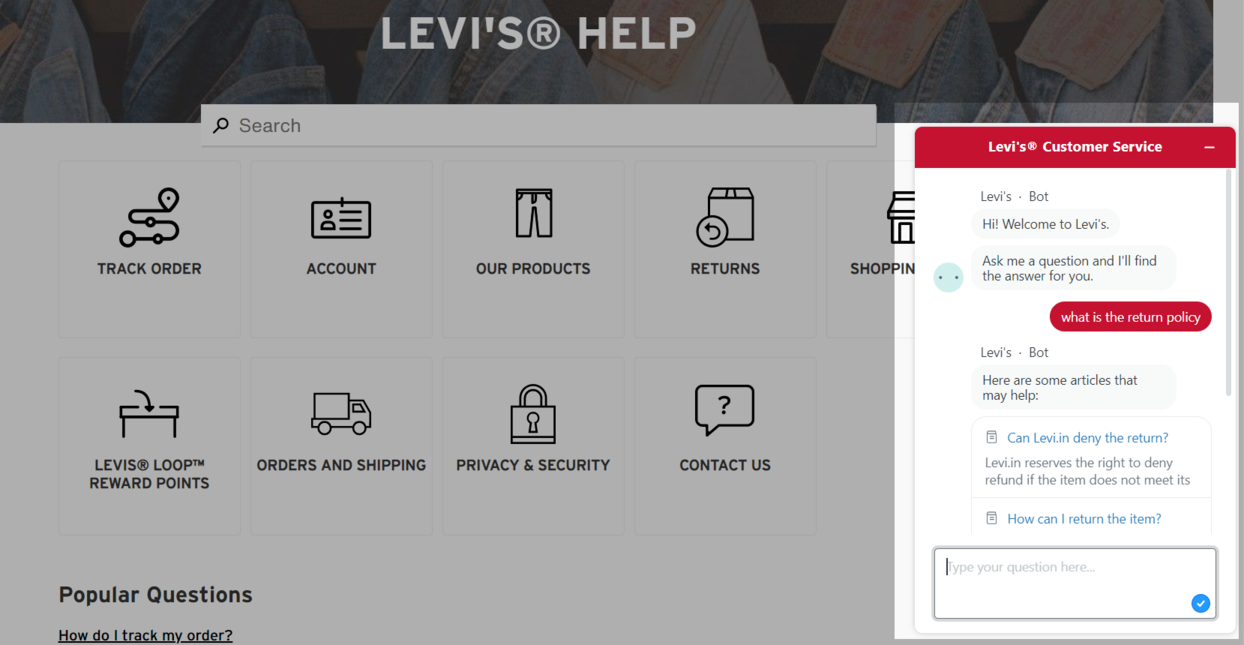
Notice how Levi’s eCommerce, a renowned American clothing brand, uses a chatbot to offer quick and automated responses.
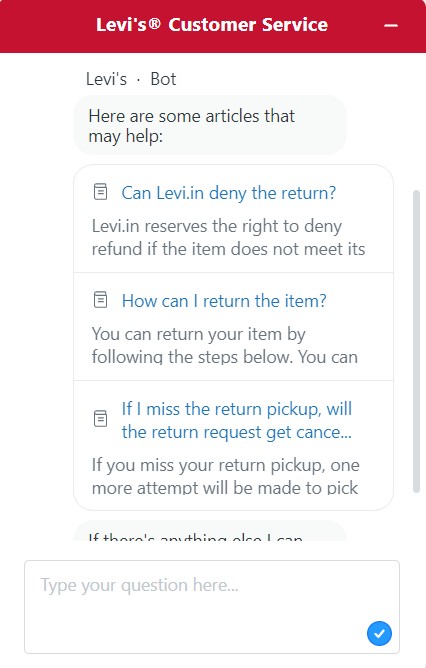
Here’s how the intelligent chatbot shares helpful and relevant digital assets to answer customer FAQs.
Assists with taking orders
Unlike human agents, eCommerce chatbots can interact with multiple customers through conversational interfaces. They can assist with taking orders while ensuring interactive communication.
For instance, eCommerce chatbots can help with the following:
- Collect customer information. Chatbots can ask for crucial details like the customer’s name and ID to begin the conversation.
- Process payments. They can guide customers on how to process payments securely. Besides, the chatbots can provide information about discounts, taxes, and ongoing promotions.
- Confirm orders. The chatbots help share order confirmation emails or messages.
What’s more? They can analyze customer preferences and needs and provide personalized recommendations to help them finalize orders.
The result: This eCommerce chatbot automation reduces the risk of human errors during online shopping, thus improving customer experience, satisfaction, and loyalty. All of these can ultimately drive sales and revenue.
Here’s how H&M, a multinational clothing brand, utilizes a chatbot to help customers. Notice how it guides them through the payment process to ensure they place the order seamlessly.
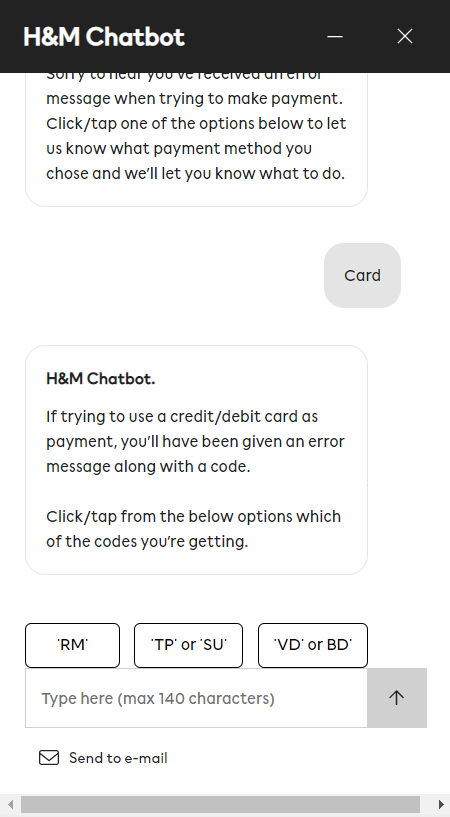
What’s more? Customers can chat with their human agents for more guidance at any instant.
Assists with sharing relevant product information
A McKinsey report states customers research multiple digital channels before buying a product. eCommerce chatbots can help share product details with customers via website conversations, email campaigns, and more to ease their decision-making.
Here’s what eCommerce chatbots can share:
- In-depth blog posts. Blog posts with detailed descriptions of the product’s unique features, functionalities, specifications, and benefits.
- Compelling visuals. High-quality visuals, including videos highlighting the product features.
- Pricing information. Transparent pricing information, including additional promotions and discounts.
- Shipping details. Exact details on shipping costs, timeframe, and delivery options based on customer location.
- Social proof. Customer testimonials on the product’s quality, durability, and features.
- Product availability. Real-time updates on the product’s availability (especially when it’s out of stock).
The result: Sharing these insights helps eCommerce businesses enhance customer experience, and win their trust, thus increasing the likelihood of a purchase. Besides, this allows customers to make informed purchase decisions, thus reducing the chances of cancellation and returns. This can boost brand awareness and revenue.
Most eCommerce brands’ chatbots offer relevant product information to boost brand awareness. However, observe the creativity of Casper Sleep, the award-winning mattress and sleep products brand. They created an innovative chatbot called “Insomnobot-3000” to boost brand awareness.

This chatbot engages insomniacs, people who can’t fall asleep easily. This way, the company indirectly taps into the target market. The strategy is to boost brand awareness and attract leads and conversions.
Helps brands collect accurate, real-time customer feedback
Collecting and analyzing customer feedback can be a big headache for eCommerce brands. The feedback can sometimes lack context, making it difficult for the customer service reps to understand customers’ suggestions.
eCommerce chatbots can automate the process by capturing feedback in various ways, including:
- Surveys and polls. Chatbots can conduct surveys and polls to understand customer experience across distinct stages.
- Feedback forms. They can share customized feedback forms to comprehend customers’ shopping experiences.
- Proactive engagement. If a customer spends a long time on a particular product page, a chatbot can pop up to provide service assistance. It can also ask for suggestions to improve their browsing experience.
- Sentiment analysis. Chatbots can offer sentiment analysis to analyze customer feedback. This allows eCommerce brands to understand customer perception of them.
The result: Chatbots can help eCommerce brands gather customer insights in real-time and respond to their concerns quickly, thus improving the overall customer experience with zero manual efforts and 100% accuracy.
Here’s how eBay, an American multinational eCommerce, leverages chatbots to gain customer feedback. The chatbot directs customers to a custom feedback form page to understand the aspects they can improve.
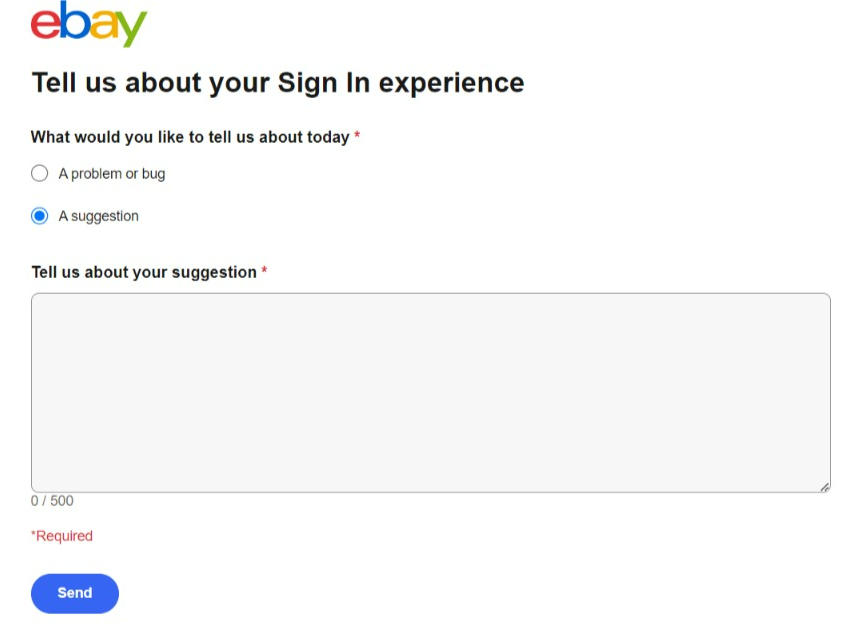
Conclusion
We hope the advantages of eCommerce chatbots will encourage you to leverage them to boost brand engagement, awareness, and revenue.
Take inspiration from the leading eCommerce brand examples shared in this post.
If you’re aiming to build an efficient and powerful chatbot for your eCommerce business, try SendPulse’s chatbot builder! With advanced features and integrations with popular messaging and social apps, it’s a powerful tool to automate your customer support and sales.








